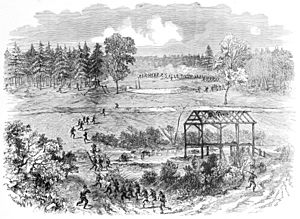Battle of Boydton Plank Road facts for kids
Quick facts for kids Battle of the Boydton Plank Road |
|||||||
|---|---|---|---|---|---|---|---|
| Part of the American Civil War | |||||||
 Second Corps US Army under Hancock outflanking Confederate works at Armstrong's Mill, October 27 |
|||||||
|
|||||||
| Belligerents | |||||||
| Commanders and leaders | |||||||
| Winfield S. Hancock | Henry Heth | ||||||
| Units involved | |||||||
| II Corps V Corps IX Corps |
Third Corps | ||||||
| Strength | |||||||
| 30,000 | 11,691 | ||||||
| Casualties and losses | |||||||
| 1,758 | 1,300 | ||||||
The Battle of the Boydton Plank Road was a fight during the American Civil War. It happened on October 27–28, 1864. This battle was part of the siege of Petersburg, a long fight around the city of Petersburg, Virginia. The Union Army tried to capture the Boydton Plank Road. This road was a very important supply route for the Confederate soldiers in Petersburg. They also wanted to cut the South Side Railroad, another key supply line.
Contents
Why the Battle Happened
Earlier in October, Union soldiers had taken control of some Confederate defenses. These defenses were near a place called Hatcher's Run. The Union commanders wanted to push further. They hoped to cut off supplies to the Confederates in Petersburg.
The Union's Second Corps, led by Major General Winfield Scott Hancock, was chosen for this mission. They were joined by soldiers from the Fifth Corps and Ninth Corps. Cavalry (soldiers on horseback) also helped. Their goal was to attack the Confederate "Boydton Line."
The Battle Begins
On October 27, General Hancock's soldiers marched across Hatcher's Run. They easily pushed past Confederate guards. Then, they moved around the side of the Confederate lines towards Burgess Mill.
One Union division, led by Brigadier General Gershom Mott, crossed the Boydton Plank Road. They attacked Confederate cavalry led by Wade Hampton III. This attack threatened to cut off the Confederates.
The Confederate commander in the area, A. P. Hill, quickly reacted. But he was too sick to lead his soldiers in the field. So, he gave command to Henry Heth. General Heth sent two divisions to stop Hancock.
Hancock's Union soldiers pushed forward along the Boydton Plank Road. They forced the Confederates back.
A Risky Plan
Both Union Generals George Meade and Ulysses S. Grant came to the battlefield. General Meade noticed a big gap between Hancock's soldiers and the V Corps. The important South Side Railroad was still about 6 miles away. Meade realized that pushing further would make Hancock's soldiers too spread out and vulnerable. He ordered Hancock to stop.
A division from the V Corps, led by Samuel W. Crawford, was supposed to connect with Hancock's soldiers. But they got lost in thick woods. General Grant saw that the Confederate defenses were too strong. He decided to call off the attack.
Confederate Counterattack
Hancock's soldiers had not connected with Crawford's division. They tried to go back to Hatcher's Run, but Confederate cavalry blocked their way. This left Hancock's entire Second Corps trapped.
Confederate Generals Heth and Hampton saw a chance to destroy the Union Second Corps. Hancock's only way out was a road called Dabney Mill Road. General Heth aimed to capture this road.
Late in the afternoon, a Confederate division led by William Mahone attacked. They moved through the same woods that had stopped Crawford. Mahone's soldiers took control of the Dabney Mill Road. At the same time, Confederate cavalry, led by W.H.F. "Rooney" Lee, moved behind the Union soldiers.
Hancock's soldiers were now surrounded on three sides. They had no clear way to retreat. But unlike a previous battle, the Union Second Corps did not panic. Hancock took charge.
Mahone's attack had been almost too successful. His division was now isolated. Hancock ordered his soldiers to attack both sides of the Confederate forces. The Union cavalry, led by Gregg, helped push back Mahone's soldiers.
The situation had turned around. The Confederates were now in danger of being surrounded. They retreated back up the Boydton Plank Road. Hancock's soldiers still held the road. General Grant let Hancock decide whether to stay or go back. Even though Hancock had pushed back the Confederates, his position was still risky. That night, Hancock marched his soldiers back to their original lines.
What Happened Next
As October ended, both armies settled into their winter camps. The Confederates kept control of the Boydton Plank Road for the rest of the winter.
Hancock's soldiers had won a small victory against Heth's Confederates. This helped them feel better after a tough loss at Reams's Station. There were no more big battles around Petersburg for the rest of the year.
The Battle of the Boydton Plank Road was the last battle for two important Union generals in the Army of the Potomac. The next month, Winfield Scott Hancock left his command. This was because of problems from a wound he got at the Battle of Gettysburg. Then, in January 1865, David McMurtrie Gregg also resigned. He said he was worried about being away from home.
Andrew A. Humphreys took over command of the Second Corps. He would lead another attack on the Boydton Plank Road in February of the next year.
Images for kids


